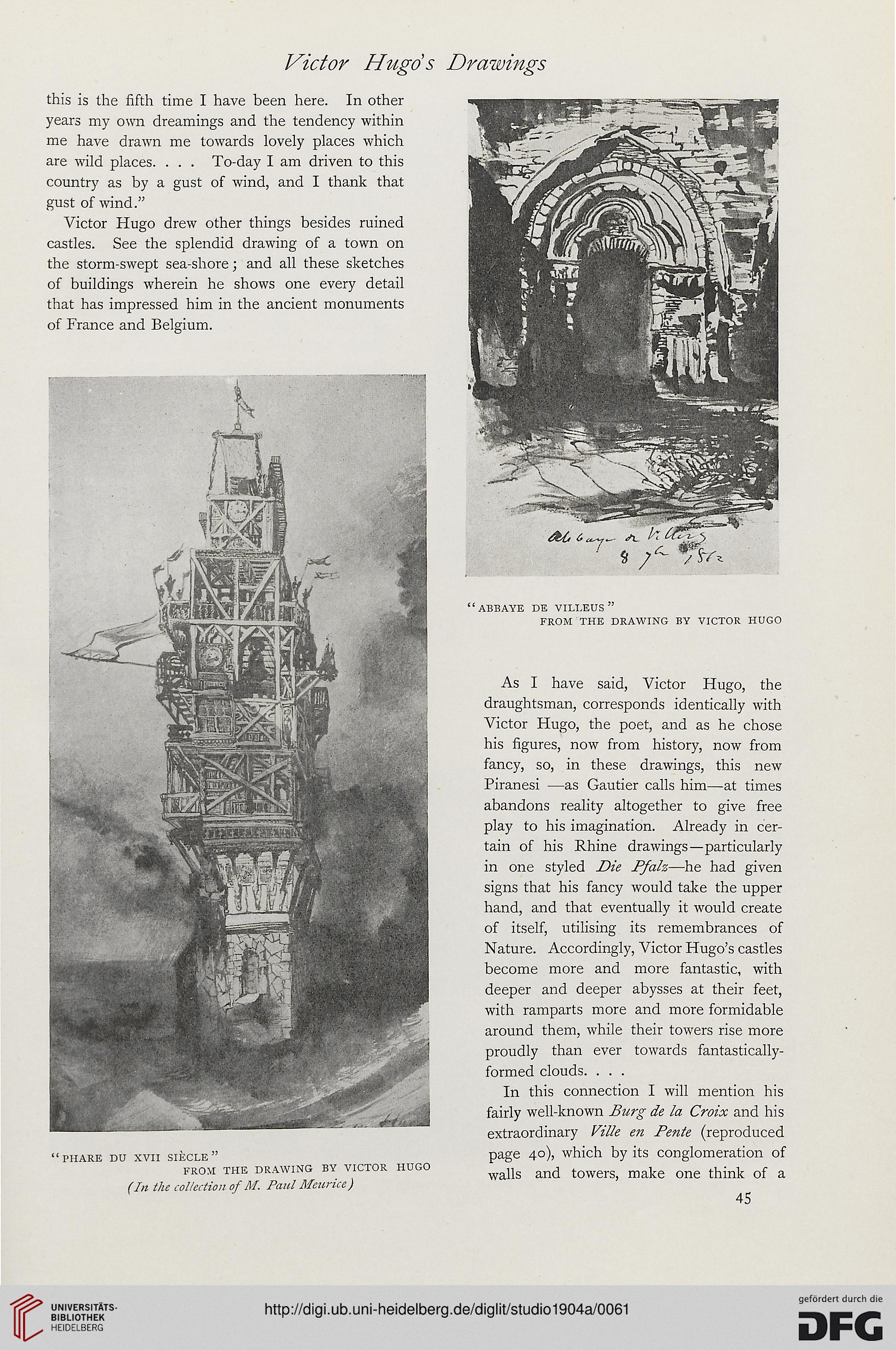Victor Hugos
this is the fifth time I have been here. In other
years my own dreamings and the tendency within
me have drawn me towards lovely places which
are wild places. . . . To-day I am driven to this
country as by a gust of wind, and I thank that
gust of wind."
Victor Hugo drew other things besides ruined
castles. See the splendid drawing of a town on
the storm-swept sea-shore; and all these sketches
of buildings wherein he shows one every detail
that has impressed him in the ancient monuments
of France and Belgium.
" PHARE DU XVII SIECLE"
FROM THE DRAWING BY VICTOR HUGO
(In the collection of M. Paul Meurice)
Drawings
"ABBAYE DE VILI.EUS "
FROM THE DRAWING BY VICTOR HUGO
As I have said, Victor Hugo, the
draughtsman, corresponds identically with
Victor Hugo, the poet, and as he chose
his figures, now from history, now from
fancy, so, in these drawings, this new
Piranesi —as Gautier calls him—at times
abandons reality altogether to give free
play to his imagination. Already in cer-
tain of his Rhine drawings—particularly
in one styled Die Pfah—he had given
signs that his fancy would take the upper
hand, and that eventually it would create
of itself, utilising its remembrances of
Nature. Accordingly, Victor Hugo's castles
become more and more fantastic, with
deeper and deeper abysses at their feet,
with ramparts more and more formidable
around them, while their towers rise more
proudly than ever towards fantastically-
formed clouds. . . .
In this connection I will mention his
fairly well-known Burg de la Croix and his
extraordinary Ville en Pente (reproduced
page 40), which by its conglomeration of
walls and towers, make one think of a
45
this is the fifth time I have been here. In other
years my own dreamings and the tendency within
me have drawn me towards lovely places which
are wild places. . . . To-day I am driven to this
country as by a gust of wind, and I thank that
gust of wind."
Victor Hugo drew other things besides ruined
castles. See the splendid drawing of a town on
the storm-swept sea-shore; and all these sketches
of buildings wherein he shows one every detail
that has impressed him in the ancient monuments
of France and Belgium.
" PHARE DU XVII SIECLE"
FROM THE DRAWING BY VICTOR HUGO
(In the collection of M. Paul Meurice)
Drawings
"ABBAYE DE VILI.EUS "
FROM THE DRAWING BY VICTOR HUGO
As I have said, Victor Hugo, the
draughtsman, corresponds identically with
Victor Hugo, the poet, and as he chose
his figures, now from history, now from
fancy, so, in these drawings, this new
Piranesi —as Gautier calls him—at times
abandons reality altogether to give free
play to his imagination. Already in cer-
tain of his Rhine drawings—particularly
in one styled Die Pfah—he had given
signs that his fancy would take the upper
hand, and that eventually it would create
of itself, utilising its remembrances of
Nature. Accordingly, Victor Hugo's castles
become more and more fantastic, with
deeper and deeper abysses at their feet,
with ramparts more and more formidable
around them, while their towers rise more
proudly than ever towards fantastically-
formed clouds. . . .
In this connection I will mention his
fairly well-known Burg de la Croix and his
extraordinary Ville en Pente (reproduced
page 40), which by its conglomeration of
walls and towers, make one think of a
45




